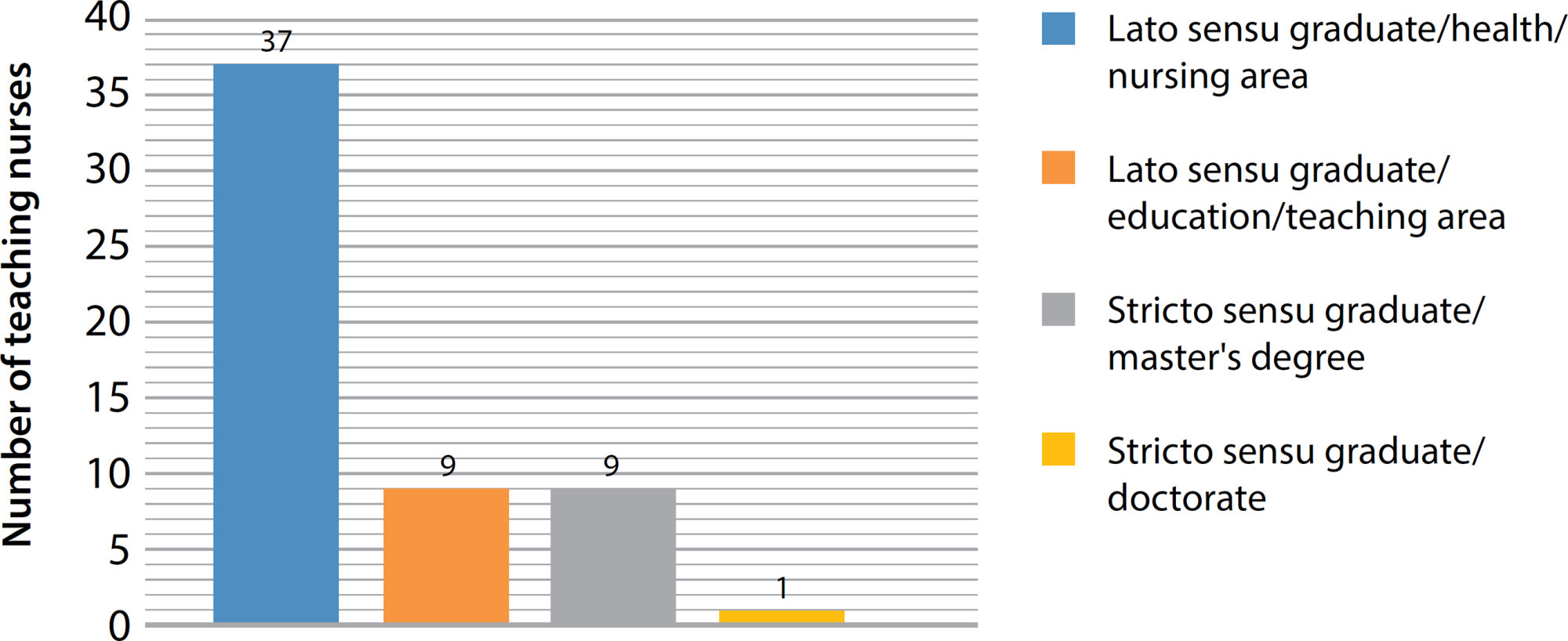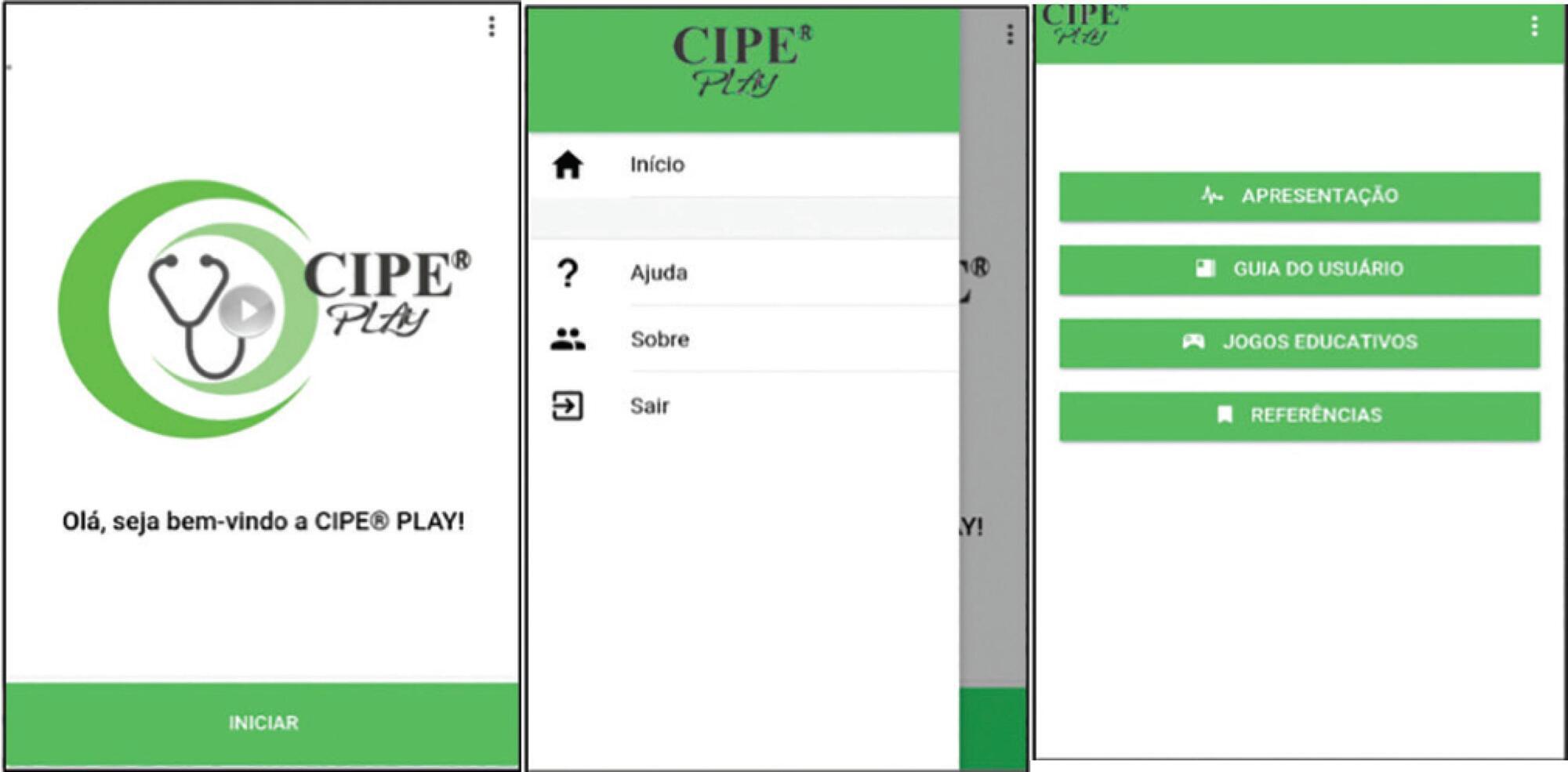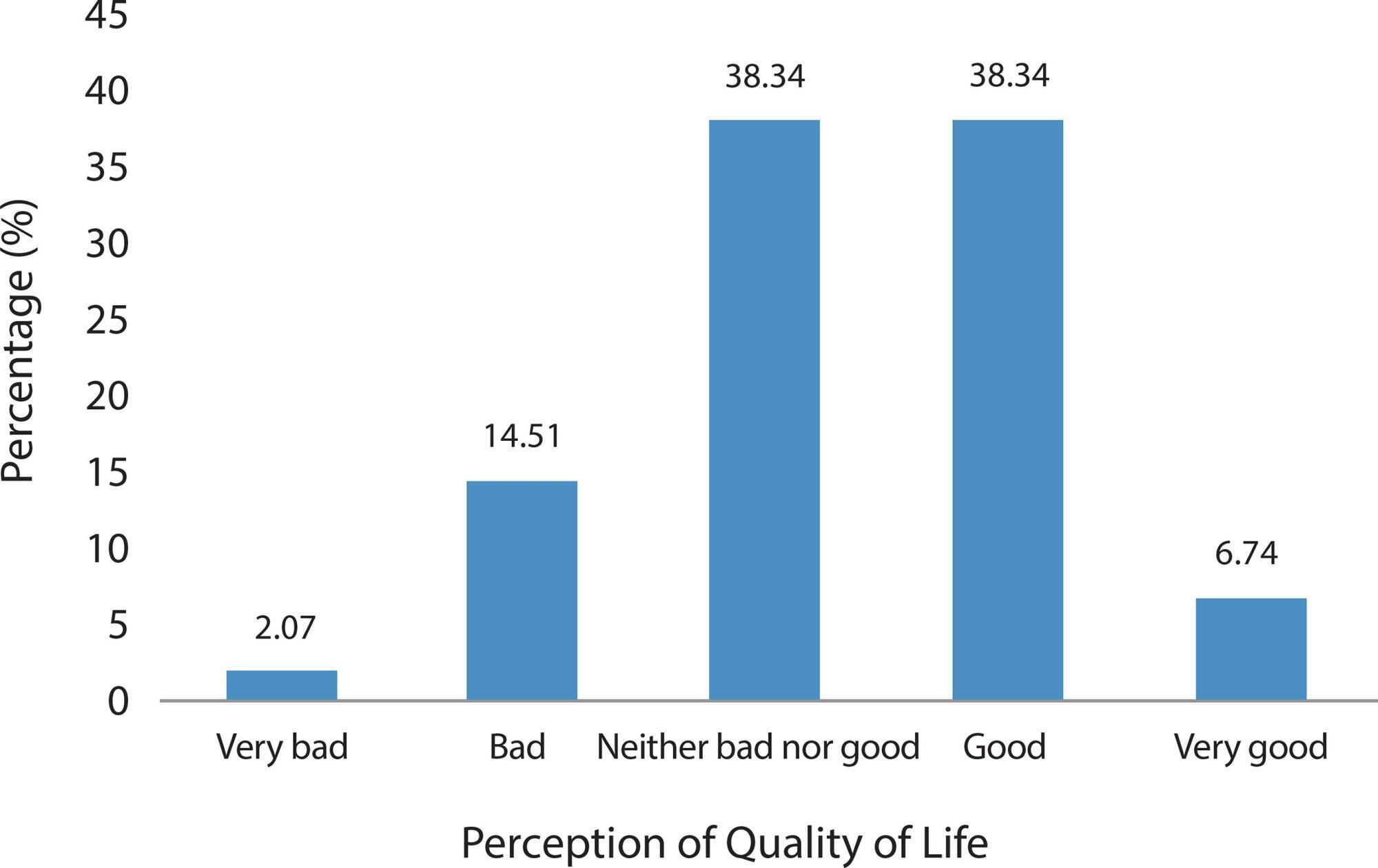-
ORIGINAL ARTICLE10-01-2022
Mental health assistance: identification of nursing diagnoses in a community mental health service
Revista Brasileira de Enfermagem. 2022;75(2):e20201175
Abstract
ORIGINAL ARTICLEMental health assistance: identification of nursing diagnoses in a community mental health service
Revista Brasileira de Enfermagem. 2022;75(2):e20201175
DOI 10.1590/0034-7167-2020-1175
Views0See moreABSTRACT
Objective:
to map and identify nursing diagnoses targeted at night care users in a Psychosocial Care Center according to NANDA-I Taxonomy.
Method:
this is a descriptive-exploratory study, of documentary research type of 319 records in medical records. It was held in a Psychosocial Care Center III in Goiás, from 2014-2018. Nursing diagnoses and records were extracted with non-standardized language.
Results:
813 records of nursing diagnoses identified in 53 different titles, in 10 domains, were identified. The most frequent diagnosis was risk for self-extermination. The domain with the highest number of diagnostic records was activity/rest. There was a predominance of diagnoses focused on the problem.
Final considerations:
mapping contributes to the planning of evidence-based nursing interventions and to the strengthening of professional identity in mental health. It is evident the need for practices that go beyond the symptoms in a preventive perspective, with a view to comprehensiveness.
-
ORIGINAL ARTICLE10-01-2022
Training-professional profile of nurses teaching at the Technical Schools of the Unified Health System
Revista Brasileira de Enfermagem. 2022;75(2):e20201142
Abstract
ORIGINAL ARTICLETraining-professional profile of nurses teaching at the Technical Schools of the Unified Health System
Revista Brasileira de Enfermagem. 2022;75(2):e20201142
DOI 10.1590/0034-7167-2020-1142
Views0See moreABSTRACT
Objective:
to describe the training-professional profile of nursing professors in the vocational course in nursing at the Technical Schools of the Unified Health System.
Methods:
a quantitative descriptive research, carried out with 61 nurses who are professors of technical courses in nursing at five technical schools in three Brazilian regions. Data were collected through an online questionnaire and submitted to descriptive analysis.
Results:
only 36% of teaching nurses were licensed and 80% had a specialization in nursing or health. Although 95.1% of participants considered training for teaching necessary, 44.2% did not have qualifications for this job. The average length of work in care was 8 years, focusing on the hospital network.
Conclusion:
the need for professor training and investment in it is evidenced, as the training of essential workers for nursing care and consolidation of the Unified Health System is on the agenda.

-
ORIGINAL ARTICLE10-01-2022
Continuing health education for qualification of professional practice in Psychosocial Care Centers
Revista Brasileira de Enfermagem. 2022;75(2):e20210155
Abstract
ORIGINAL ARTICLEContinuing health education for qualification of professional practice in Psychosocial Care Centers
Revista Brasileira de Enfermagem. 2022;75(2):e20210155
DOI 10.1590/0034-7167-2021-0155
Views0See moreABSTRACT
Objective:
to describe and analyze a strategy of continuing health education to manage the quality of professionals’ work in Psychosocial Care Centers.
Method:
this is a research-intervention carried out in Psychosocial Care Centers in the state of Goiás, Brazil, with the participation of 58 professionals. Data were collected in 2016 through seminars and workshops. Thematic content analysis was carried out.
Results:
professionals associated the Singular Therapeutic Project to the record of performed procedures and described the need to develop skills for correct completion and interpretation of procedures, use of a record software and computerization of processes. The qualification strategy used was considered to be effective in making improvements to the work carried out feasible.
Final Considerations:
the study presents a qualification strategy for community mental health service teams to guide the care model for territorial care centered on users.

-
ORIGINAL ARTICLE10-01-2022
Frailty in the elderly: screening possibilities in Primary Health Care
Revista Brasileira de Enfermagem. 2022;75(2):e20200973
Abstract
ORIGINAL ARTICLEFrailty in the elderly: screening possibilities in Primary Health Care
Revista Brasileira de Enfermagem. 2022;75(2):e20200973
DOI 10.1590/0034-7167-2020-0973
Views0See moreABSTRACT
Objectives:
to evaluate two instruments for screening frailty in the elderly in Primary Health Care.
Methods:
this is an observational, cross-sectional study, with a quantitative approach, with 396 elderly people. SPSS software helped to perform the statistical analyses. The study used the kappa coefficient and Spearman’s correlation.
Results:
the kappa coefficient between the Clinical-Functional Vulnerability Index 20 and the Edmonton Frailty Scale was 0.496, considered moderate. There was a positive and significant correlation (r = 0.77; p < 0.001) between the frailty conditions and the total score of the two instruments.
Conclusions:
when this article assessed fragility through the kappa coefficient, both instruments presented positive correlation and agreement. However, the identification of frailty was higher when it used the Edmonton Frailty Scale.
-
ORIGINAL ARTICLE10-01-2022
Factors associated with vulnerability and fragility in the elderly: a cross-sectional study
Revista Brasileira de Enfermagem. 2022;75(2):e20200399
Abstract
ORIGINAL ARTICLEFactors associated with vulnerability and fragility in the elderly: a cross-sectional study
Revista Brasileira de Enfermagem. 2022;75(2):e20200399
DOI 10.1590/0034-7167-2020-0399
Views0See moreABSTRACT
Objectives:
to assess factors associated with vulnerability and fragility in the elderly.
Methods:
crosssectional study with 384 elderly people in Fortaleza, Ceará. The Vulnerable Elders Survey and Clinical-Functional Vulnerability Index – 20 were used. Chi-square and Fisher’s exact tests were used for associations. In the analysis of the combined influence of risk factors, the stepwise logistic regression and multinomial regression methods were adopted.
Results:
251 (65.4%) non-vulnerable and 133 (34.6%) vulnerable elders. From the vulnerable elders analyzed, 42 (30.9%) are at high risk for frailty. Factors associated with vulnerability: age, gender, presence of comorbidities, hypertension, diabetes, osteoporosis and use of polypharmacy. There is a 30% increase in the chance of vulnerability for each additional drug. Physical activity reduces the chance of vulnerability by 60%. Factors associated with frailty: educational level; self-perception of health; comorbidities; polypharmacy.
Conclusions:
it is important to pay attention to the presence of arterial hypertension, osteoporosis, polypharmacy, and encourage the practice of physical activity.
-
10-01-2022
Sintomas musculoesqueléticos em cuidadores formais e informais de idosos
Revista Brasileira de Enfermagem. 2022;75(2):e20210249
Abstract
Sintomas musculoesqueléticos em cuidadores formais e informais de idosos
Revista Brasileira de Enfermagem. 2022;75(2):e20210249
DOI 10.1590/0034-7167-2021-0249
Views0See moreRESUMEN
Objetivo:
Evaluar los síntomas musculoesqueléticos en cuidadores formales e informales de los ancianos y verificar la asociación con factores personales y laborales. Métodos: Estudio transversal. Los instrumentos para la evaluación fueron el Cuestionario Internacional de Actividad Física (IPAQ), Self-Reporting Questionnaire-20, Escala de Percepción del Esfuerzo de Borg y el Cuestionario Nórdico de Síntomas Musculoesqueléticos.
Resultados:
Los cuidadores informales trabajaron más tiempo (60,2% vs. 41%), tuvieron más horas de trabajo (37,4% >12h por día), menos tiempo libre (85,4% vs. 2,5%) y falta de pautas de atención (90,2%). La región con más síntomas musculoesqueléticos fue la columna vertebral y, cuanto mayor la dependencia de los ancianos, mayores son las posibilidades de desarrollar síntomas musculoesqueléticos (OR= 1.3, 95% CI= 1.1-1.6, p <0.05).
Conclusión:
Factores personales y relacionados con el trabajo fueron más frecuentes en los cuidadores informales y la dependencia de los ancianos interfiere con el aumento de los síntomas musculoesqueléticos en cuidadores.
-
ORIGINAL ARTICLE10-01-2022
ICNP® terminology subset for the care of people with heart failure
Revista Brasileira de Enfermagem. 2022;75(2):e20210196
Abstract
ORIGINAL ARTICLEICNP® terminology subset for the care of people with heart failure
Revista Brasileira de Enfermagem. 2022;75(2):e20210196
DOI 10.1590/0034-7167-2021-0196
Views0See moreABSTRACT
Objective:
to develop an ICNP® terminology subset for the care of people with heart failure.
Methods:
this is a methodological study, which used the theoretical framework of the Mid-Range Nursing Theory for Cardiovascular Rehabilitation, with the steps: Construction of nursing diagnoses/outcomes and interventions statements and Cross-mapping of statements constructed.
Results:
forty-two diagnosis/outcome statements and 179 nursing intervention statements were constructed, organized based on five theory concepts, with a higher prevalence of statements related to “Rehabilitative care”, “Psychosocial support for patients and families” and “Supervised cardiovascular rehabilitation program”.
Final considerations:
it was possible to build nursing diagnosis/outcome and intervention statements for developing a terminology subset for the care of people with heart failure, based on the chosen theory.
-
10-01-2022
Kangaroo Method: potentialities, barriers and difficulties in humanized care for newborns in the Neonatal ICU
Revista Brasileira de Enfermagem. 2022;75(2):e20201121
Abstract
Kangaroo Method: potentialities, barriers and difficulties in humanized care for newborns in the Neonatal ICU
Revista Brasileira de Enfermagem. 2022;75(2):e20201121
DOI 10.1590/0034-7167-2020-1121
Views0See moreABSTRACT
Objective:
To identify the potentialities, barriers and difficulties for the implementation of humanized care from the perspective of the Kangaroo Method.
Methods:
Integrative literature review with a time cut from 02/01/2015 to 06/01/2019, totaling ten articles in the final sample.
Results:
The findings were categorized into two categories: Potentialities for humanized care from the perspective of the Kangaroo Method; Barriers or difficulties to the implementation of the Kangaroo Method. Several potentialities for humanized care allied to technology and continuing education were identified, as well as several barriers to the implementation of the Kangaroo Method, such as lack of physical space, lack of professionals and team training, lack of knowledge, lack of adherence and professional demotivation.
Final considerations:
There are still few studies that address the potentialities, barriers and difficulties for the implementation of humanized care from the perspective of the Kangaroo Method, and most of those included in this review were conducted in Brazil and present a qualitative approach.

-
ORIGINAL ARTICLE08-19-2019
Mobile application for the teaching of the International Classification for Nursing Practice
Revista Brasileira de Enfermagem. 2019;72(4):1020-1027
Abstract
ORIGINAL ARTICLEMobile application for the teaching of the International Classification for Nursing Practice
Revista Brasileira de Enfermagem. 2019;72(4):1020-1027
DOI 10.1590/0034-7167-2018-0751
Views0See moreABSTRACT
Objective:
Developing a mobile application for the teaching of the International Classification for Nursing Practice.
Methods:
Methodological applied research for technological production, performed in three phases of the contextualized instructional design model: analysis, design and development.
Results:
The application has an initial screen, which provides information about the team and its purpose. Then, four moblets are listed, including presentation, user’s guide consisting of five modules, educational games and five clinical cases. The references on which the application was based are also presented.
Final considerations:
It was possible to develop an application with the potential to promote the knowledge of nursing students and professionals about this classification system.

-
ORIGINAL ARTICLE08-14-2020
Education to prevent ventilator-associated pneumonia in intensive care unit
Revista Brasileira de Enfermagem. 2020;73(6):e20190477
Abstract
ORIGINAL ARTICLEEducation to prevent ventilator-associated pneumonia in intensive care unit
Revista Brasileira de Enfermagem. 2020;73(6):e20190477
DOI 10.1590/0034-7167-2019-0477
Views0INTRODUCTIONVentilator-Associated Pneumonia (VAP) is one of the complications related to the care of patients hospitalized in the Intensive Care Unit (ICU), which, according to consulted authors, exceeds the mortality rates of other Healthcare Related Infections (HRI). VAP is the second most frequent infection in patients admitted to the ICU, as well as the most prevalent […]See more
-
08-19-2019
Degree in Nursing: education through problem-based learning
Revista Brasileira de Enfermagem. 2019;72(4):1071-1077
Abstract
Degree in Nursing: education through problem-based learning
Revista Brasileira de Enfermagem. 2019;72(4):1071-1077
DOI 10.1590/0034-7167-2018-0298
Views0See moreABSTRACT
Objective:
To describe how undergraduate courses in Nursing are using the problem-based learning (PBL).
Method:
Integrative literature review, from searches in the databases Education Resources Information Center (ERIC), Latin American and Caribbean Health Sciences Literature (Lilacs), and PubMed, from 2010 to 2015. 36 articles were analyzed.
Results:
A teaching method used in all continents, the PBL enables improvement of the critical thinking, autonomy, motivation for learning, active search attitude, ability to work in teams, and problem-solving. Difficulties and challenges relate to the training of students and teachers to understand the principles of the method.
Final considerations:
The benefits of PBL coincide with the needs of nursing training, but its applicability demands constant review in seeking to develop the skills necessary for this training.

-
ORIGINAL ARTICLE12-13-2019
Mobile health technology for gestational care: evaluation of the GestAção’s app
Revista Brasileira de Enfermagem. 2019;72:266-273
Abstract
ORIGINAL ARTICLEMobile health technology for gestational care: evaluation of the GestAção’s app
Revista Brasileira de Enfermagem. 2019;72:266-273
DOI 10.1590/0034-7167-2018-0641
Views0See moreABSTRACT
Objective:
to evaluate the GestAção application, based on the experience of pregnant women use.
Method:
an evaluative, applied, methodological, quantitative-qualitative study. This tool was evaluated by 13 pregnant women through questionnaires for sociodemographic profile characterization and Likert scale use to calculate Content Validity Index (CVI); and semi-structured interview, with analysis based on Semiotics.
Results:
the study evidenced a significant level of satisfaction of pregnant women with the application use, considering the objectives (CVI = 0.92), structure and presentation (CVI = 0.86), and relevance (CVI = 0.92).
Final considerations:
the GestAção application obtained an overall CVI of 0.90, evidencing it as a facilitating and supporting technology in the empowerment of pregnant women interested in obtaining knowledge about pregnancy. It has been proved to be a powerful tool to qualify good practices in nursing consultation.
-
REFLECTION06-29-2020
Children’s (in)visibility in social vulnerability and the impact of the novel coronavirus (COVID-19)
Revista Brasileira de Enfermagem. 2020;73:e20200302
Abstract
REFLECTIONChildren’s (in)visibility in social vulnerability and the impact of the novel coronavirus (COVID-19)
Revista Brasileira de Enfermagem. 2020;73:e20200302
DOI 10.1590/0034-7167-2020-0302
Views0See moreABSTRACT
Objective:
To examine the impact of the infection by the novel coronavirus on Brazilian children in situation of social vulnerability based on the Millennium Sustainable Development Goals.
Method:
Reflective study based on discursive formulation in three aspects: principles of the objectives and goals for the millennium sustainable development; impact of the pandemic on the health of children and their families living in social vulnerability; and the role of pediatric nursing in the care provided – limits and challenges.
Results:
In January 2020, the news of COVID 19 is released as a pandemic. In Brazil, children and families are still without access to basic rights, thereby increasing their risks of social vulnerability because of the quarantine. The nursing field has an important role in monitoring children and their families, offering guidance in search for solutions and preventing contamination.
Conclusion:
There are still challenges to be overcome by the children and their families in situations of vulnerability against COVID-19.
-
ORIGINAL ARTICLE07-10-2020
Profile of nursing students: quality of life, sleep and eating habits
Revista Brasileira de Enfermagem. 2020;73:e20190365
Abstract
ORIGINAL ARTICLEProfile of nursing students: quality of life, sleep and eating habits
Revista Brasileira de Enfermagem. 2020;73:e20190365
DOI 10.1590/0034-7167-2019-0365
Views0See moreABSTRACT
Objective:
to profile and analyze sleep quality, quality of life and eating habits of nursing students.
Methods:
a cross-sectional, comparative and correlational study with the following variables: sociodemographic characteristics, Pittsburgh sleep quality index, quality of life and eating habits. One hundred ninety-five students participated in the study.
Results:
participants were on average 24 years old. Results showed that females were prevalent (87.1%); 71.0% of the students had poor sleep quality; 98.9% used electronic devices before bedtime. Self-perception of quality of life was indifferent (38.3%), and self-perception of general health, 36.9% expressed satisfaction. Among the participants, 45.13% consumed one portion of fruit and 40.66% two to three portions of vegetables daily.
Conclusion:
the study allowed the profile of these students, sedentary, overweight and poor sleep quality young students who studied and worked.

-
ORIGINAL ARTICLE06-09-2020
Stress of nursing professionals working in pre-hospital care
Revista Brasileira de Enfermagem. 2020;73(2):e20180660
Abstract
ORIGINAL ARTICLEStress of nursing professionals working in pre-hospital care
Revista Brasileira de Enfermagem. 2020;73(2):e20180660
DOI 10.1590/0034-7167-2018-0660
Views0See moreABSTRACT
Objectives:
To analyze the factors related to the occupational stress of a Mobile Emergency Care Service (Samu) nursing team.
Methods:
This is a descriptive study, with a quantitative approach, performed with nursing professionals from Samu service of a city of Pernambuco. A sociodemographic questionnaire and the Lipp’s Stress Symptom Inventory were used.
Results:
The participants presenting stress (24.6%) were classified in the phases: resistance (19.7%), exhaustion (4.4%) and near exhaustion (0.5%). It was also observed an association of stress level with the following factors: gender, sleep quality, professional autonomy restriction, emotional exhaustion with work performed and work in inadequate or unhealthy physical facilities.
Conclusions:
Although showing low occurrence of stress, this study pointed out the profile that presents the highest risk of developing occupational stress, through the factors significantly associated with stress in the studied population.
-
ORIGINAL ARTICLE07-10-2020
Nursing appeals on social media in times of coronavirus
Revista Brasileira de Enfermagem. 2020;73:e20200225
Abstract
ORIGINAL ARTICLENursing appeals on social media in times of coronavirus
Revista Brasileira de Enfermagem. 2020;73:e20200225
DOI 10.1590/0034-7167-2020-0225
Views0See moreABSTRACT
Objective:
to know and analyze the nursing appeals on social media during the COVID-19 pandemic.
Method:
it is a documentary, qualitative, descriptive, and exploratory research with data collected in publications in two social media. Two hundred ninety-five publications of nursing professionals published on Twitter and Instagram between March 11 and 20, 2020 were submitted to content analysis using ATLAS.ti resources.
Results:
four thematic categories emerged: #stayathome, #whereismyPPE, #nowweareheroes, #nothingnewinthefrontline, according to frequency of communications. The appeals show a relationship with the social relevance of nursing professional work and with the conditions required for its exercise.
Final considerations:
old and new challenges of the profession were placed on the agenda in social media, especially related to the workforce and instruments of labor. These speeches can serve as a foundation for policies to improve working conditions and promote appreciation of the profession.

Search
Search in:
Nuvem de Tags
Adolescente (85) Atenção Primária à Saúde (239) COVID-19 (91) Criança (91) Cuidados de Enfermagem (269) Educação em Enfermagem (151) Educação em Saúde (139) Enfermagem (930) Enfermagem Pediátrica (86) Estudantes de Enfermagem (77) Estudos de Validação (131) Família (87) Idoso (208) Promoção da Saúde (99) Qualidade de Vida (104) Saúde do Trabalhador (86) Saúde Mental (145) Saúde Pública (82) Segurança do Paciente (150) Tecnologia Educacional (100)



